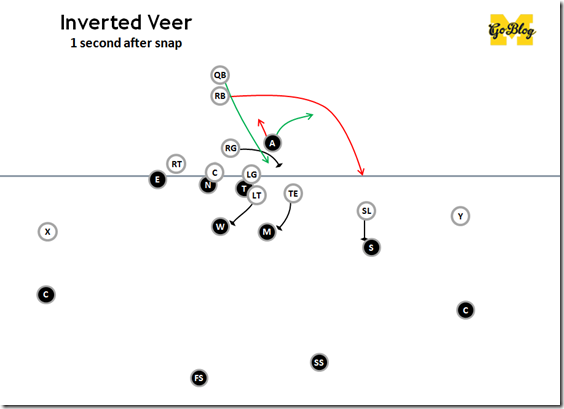inverted veer option

One of the questions we pondered after Saturday's game was where were the "July Drive" plays? By that we mean the weird stuff that coaches draw up over the summer and keep in their back pockets to spring on a specific opponent. Michigan certainly had this game circled on the calendar after last year's B.S. We all know Michigan State defines its entire program by hating this one opponent. And what did they bring out, other than the reverse with a QB lead blocking (that Michigan ran against them in 2013)?
Well, it was there. MSU's scripted opening drive was interrupted by penalties starting on the next snap, and the next was thrown off script by the 4th down stuff. So now State is back in the saddle and ready to do more with this tight end motion game they set up. You'll note in the above play they have the Y motion across the formation then give a stretch zone run look that way before reversing the opposite direction. Their next trick was to have that TE motion across then run a play-action wheel route to him out the back. You don't remember that play because Michael Barrett got on top of the wheel; Thorne was able to scramble for a chunk when Mason Graham went for a sack and Mazi Smith lost contain.
That sets us up for 1st and 10 here at the 37, and we're back on the script. For their next trick, MSU wants to run the opposite direction of the TE's motion. Here's how that goes.
What are they doing? Why didn't it work? The story's more complicated than I can break down in Upon Further Review, so let's get out the sharpies.
[After THE JUMP: It's just a rotation.]
This series is a work-in-progress glossary of football concepts we tend to talk about in these pages. Previously:
Offensive concepts: RPOs, high-low, snag, covered/ineligible receivers, Duo, zone vs gap blocking, zone stretch, split zone, reach block, kickout block, wham block, Y banana play, TRAIN
Defensive concepts: Contain & lane integrity, force player, hybrid space player, no YOU’RE a 3-4!, scrape exchange, Tampa 2, Saban-style pattern-matching, match quarters, Dantonio’s quarters, Don Brown’s 4-DL packages and 3-DL packages, Bear
Special Teams: Spread punt vs NFL-style
------------------------------------------
So today we’re going to get into a play that we’ve discussed a ton on this site: The Inverted Veer, also called a Power Read. From 2011-2013 it was the Michigan offense’s best play (even if Borges might have run it incorrectly). Since 2012 it’s also been the staple play of Ohio State’s offense. If you close your eyes and think of a collegiate Tim Tebow or Cam Newton or Cardale Jones play where they fake handoff to the running back before a QB plunged straight ahead for an unstoppable 6-8 yards, that was probably an Inverted Veer.
WHAT IS IT?
The best way to think of it is the reverse of the zone-read option. Whereas Rich Rodriguez’s option play was all about reading the backside edge defender, Inverted Veer is about optioning a frontside guy.

Basically the QB and RB will option a frontside EMLOS (end man on the line of scrimmage) by having the RB jetting outside while the QB reads the unblocked end and decides to give it to his buddy as he passes, or if the DE leaves enough space, charging downfield.
That’s it. I showed power on the diagram because that’s probably the best way to block it, but you can run this successfully with a variety of blocking so long as the DL are all secured on the backside. Major variations on it are whether you go inside or outside of the last DT you blocked, and how you want your TEs and receivers and whatever other material to execute various stalk blocks, kickouts and cracks.
It’s also a sort of personnel reversal from a zone read. On ZR the running back ends up reading his blocks and finding an interior gap, while a QB keep puts the quarterback out in space. With Inverted Veer the RB is the one threatening to edge the defense while the quarterback is charging headlong into it. That last bit is why it’s such a great play for all of those truckstick quarterbacks I mentioned: Once the defense converges that big QB will have a lot of downhill momentum.
Course a jitterbug with ridiculous change of direction is cool too.
[Hit the JUMP for some good ol’fashioned bedreaded one fun]
Okay so I’ve talked about this before. Maybe more than once. But Ohio State loves this play, so much that its variations account for 3 of the first 4 plays on Curtis Samuel’s Oklahoma highlight reel (and 2 more are counters off it).
Inverted Veer (again)
This play is called “Inverted Veer” or “Power Read.” It was the staple of the Borges-Denard/Devin fusion cuisine era, because it is the mullet of offensive plays: manball business in the front, spread party in the backfield.
Here’s a basic setup:
The offensive line is blocking like power C: block down and pull from the backside, and cave the frontside.
A second after the snap reveals why it’s such a devastating play:
While a good ol’fashioned zone-read might option a backside defender, inverted veer options the playside end man on the line of scrimmage (EMLOS). That defender is allowed into the backfield and optioned: if he comes up too far, the ball is given to the running back, who accelerates away to the outside—You’ve been EDGED! If the end gets wide to prevent the running back from getting the edge, that opens up room for the quarterback to dive into the gap behind him—You’ve been GASHED!
[Hit THE JUMP for variations, and how Michigan defended this]

35